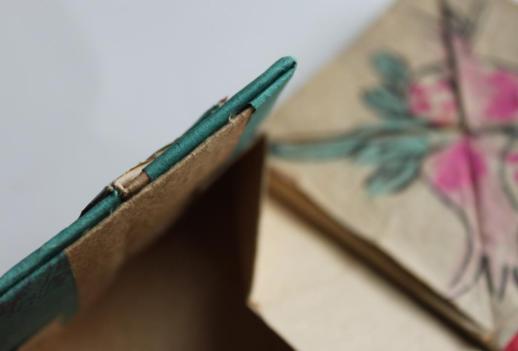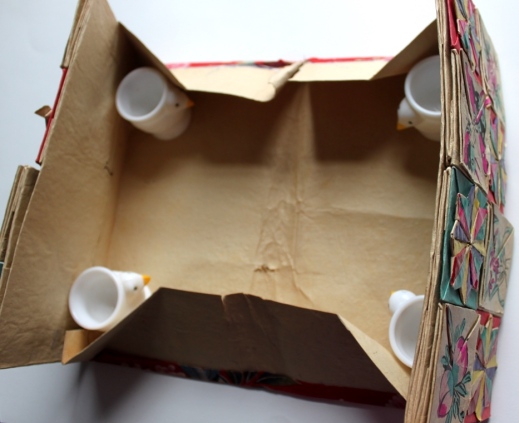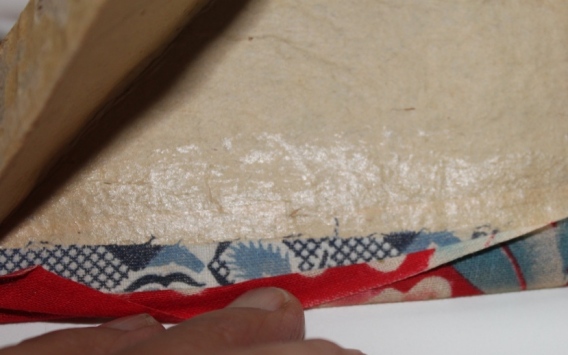
I can’t believe my good luck.
I’ve been reading about the Chinese Thread Book, devouring anything in print that I could find about it, scouring the internet then just thinking about and trying to make sense of this structure. It didn’t even occur to me that I might actually get my hands on an authentic Zhen Xian Bao.

This is how it happened. I wanted to share what I’ve been studying with book artist Ed Hutchins. When he told me that he wasn’t familiar with what I was talking about I drove to his house and dropped off Ruth Smith’s book on the subject. then received this mysterious message a few days later. Ed wrote: ” LOVED THE BOOK. I devoured it cover to cover. I’m going to try to find my zhen xian bao before you get back. keep your fingers crossed…” then a day or two later “You won’t believe this: I found the sewing kit book–AND you are going to love it!”

Turns out that even though Ed had no idea of what I was talking about, once he saw the Ruth Smith book those memory gears kicked in, and he suspected that something he had in storage, might be of interest to me. Turns out he had, many years ago, bought this item on Ebay, without knowing what it was. When he asked the seller about it, well, the seller didn’t know anything much about it either. Ed suspects that this thread book was part of an estate that was being sold off.

Here’s a variation of boxes on the top layer that I hadn’t seen in all of my perusing: this Zhen Xian Bao features both twist box, and a masu-type box on the top layer, in an alternating pattern.
Looking under the flap of the square boxes with the star on top readily reveals that this box is an embellished masu box.

There are a few things about this masu box that I’ve deemed particularly noteworthy. The first is that the green and red backgrounds of the star shapes are not hand colored, rather, these are colored papers that are adhered to the masu-box paper. The star motif is also decorated with collaged bits of colored papers. The other detail that I thought was interesting is that the masu boxes were made from a lighter weight paper than all the rest of the boxes in this thread book.

Okay, so there’s 16 square boxes, each two of which reveal a box underneath, so, between just the first and second layers there’s 24 boxes.

There’s some precise folding going on with these rectangular trays, but it’s also clear that it’s not what we think of as origami. Its been my impression that the rectangular trays traditionally are more like simple folded templates, but I will continue to make mine with origami methods for the reasons I’ve discussed in earlier posts. The decision mostly has to do with the paper. Oh, and it’s the paper in this book that makes it most convincing to me that this Zhen Xian Bao was made in China. The paper is thin, strong, and has an uneven texture. It’s certainly handmade paper, and it’s not like paper I’ve seen. Actually, this paper’s closest counterpart in my paper stash is the common grocery bag (though I am sure that this similarity is purely cosmetic!).

Next layer down! Here, each set of four top boxes pull away from each other. Now the count is up to 28 boxes.

Please excuse the purple straw holding the next layer open. Now we’re up to 30 boxes. If you are confused by the count, remember that each set of boxes has a symmetrically placed counterpart, so this open box on the right side is mirrored, but currently hidden, on the left.

Finally, here’s the Big Box layer. There are some major tears in the part of this box that articulate the spine. With the big box, there;s a total of 31 individual compartments in this book.
A secret is revealed on the big box layer that I loved seeing…. one thing that bothered me about this structure was the cover. Although there are no rock-solid rules for the cover of the Chinese Thread Book, I found the cover of this one to be somewhat out of place. But at the edges of the material that covers the big box there’s a hint of something different.
Look, at the head of the box there’s an indigo pattern on material that is underneath the red cover paper.
 There it is again, at the tail edge of the box. The red cover was somehow added on, over the original indigo cover, which is a color that makes more sense for this book. Maybe the original cover was damaged and a seller thought to recover the book to make it more sale-able?
There it is again, at the tail edge of the box. The red cover was somehow added on, over the original indigo cover, which is a color that makes more sense for this book. Maybe the original cover was damaged and a seller thought to recover the book to make it more sale-able?

I kind of plan on kind of replicating this book using my own methods. Using the measurement methods I’ve been writing about, the only measurement I will need to replicate this book is the diagonal measurement of the square that is made with the 2 x 2 square of the top-tier of boxes.

That’s it. Now I better get this book of boxes back to Ed before I get too used to having it here.
Addendum:
Here’s a map of China from Ruth Smith‘s book Zhen Xian Bao: a Little Known Chinese Folk Art. I am impressed by how few places these zhen xian bao have been found.




It’s very wonderful
LikeLiked by 1 person
Wow! Wonderful find for Ed…and nice opportunity for you.
LikeLike
Agreed! Lucky for me that Ed recognizes a treasure when he sees one.
LikeLike
Ed, himself, is a treasure. Give him a hug for me. And thank you for all the sharing of treasures on your blog. I enjoy reading it.
LikeLike
will happily give him a hug from you….
LikeLike
A very beautiful creation. This post started to sound like the next Dan Brown novel. Did you find a hidden message inside?
LikeLike
This is fascinating, Paula! I started looking I to this more, after reading your blog and seeing pictures of Ed’s book. I found numerous references to the Miao minority group in China. I traveled to that part of China, and have a number of photos and videos I’d be willing to share with you, if you’d like. Can’t wait to read more about these books in your blog!
LikeLiked by 1 person
I’d love to see what you have Chris!!
LikeLike
Hey Paula, just got on your site and saw your reply….I’ll get the Miao pics & videos together for you to see, as well as some stuff I brought back. Hope all is well…..
LikeLike
i’d bet Ed would love to see what you have too.
LikeLike
Dear Ed, I just discovered your post about your zhen xian bao from October 22th, 2016. My Name is Joan Sallas, I’m living in Weimar, Germany, leading the Archive PaDoRe on historical folding art. I work as researcher on the history of folding art in China, special on zhen xian bao. I’m very interested to be in contact with you to ask some questions about your wonderful object. Have a good day. JS
LikeLiked by 1 person
HI Joan, that’s Ed’s book you see on my blog. I’ve been enjoying this piece in his collection. Let me know your questions and I will see if I can get you the answers! Best, Paula Krieg
LikeLike
Dear Paula,
let me comment you some observations about Ed’s Chinese thread book:
On the surface they are two different models of box: eight boxes are folded in the so called „twist“ and eight in the so called „flower box“.
The twist box model appears in many Chinese provinces (and in many other parts of the world), but mainly in the southern provinces of Yúnnán and Guìzhōu, where the minorities Miao and Dong use it fot their thread book (which call shūbāo [書包]).
The flower box (and some variations of it) is documented since 1866 in old thread books from northern and eastern Chinese provinces as Shāndōng, Shànghǎi, Húběi, Héběi, Běijīng, Shānxī, Shǎnxī, Fújiàn and Gānsù.
From ca. 60 old original thread book with the flower box that I know (ca. 40 collected in the PaDoRe Archive), Ed’s Chinese thread book is the only one example that use both folding models. Because in the southern provinces of Yúnnán and Guìzhōu the flower box isn’t detected, we can think that its origin is rather from northern or east China.
The twist boxes are decorated with peach buns [寿桃, shòutáo], grape fruits [葡萄, pútáo], butterflies [蝴蝶, húdié] and cricket [蝈蝈, guō guō]. In the Han-Chinese symbolic peaches mean longevity and grape fruits with many seeds inside means many children (= happiness).
The surface of the petals by the folded flower boxes is covered and glued with papers of four different colors. This glued technic as well as this multicolored stile, is until today only documented in the northern Chinese province of Shānxī. Before we confirm this supposition about Ed’s thread book, we need to discover more old examples.
Depending of the place, the time, or the given use, this Chinese system of combined folding containers is / was called in China with different names as hébāo [盒包], hùshū [护书], qiánbāo [钱包], shūbāo [書包], wànbǎobāo [万宝包], yàngběn [样本] or zhēnxiànbāo [针线包]. I read that you call it zhēnxiànbāo, probably a cause of Ruth Smith’s book. Do you know another name?
Can you say me which size (in cm or inches) it have?
Did you find some needles, cutter patterns, threads or other objects inside of the 31 boxes that can suggest the use, or they were empty?
For future publications or conferences, could be possible obtain the permission to publish or show a picture of Ed’s thread book?
For future exhibitions on this subject, could be possible to loan it?
Thanks a lot for your answers and sorry for my so long post
have a nice day,
Joan
Weimar, Germany
LikeLiked by 2 people
Absolutely love this long post Joan! I will cut and paste this to Ed, as I am sure that he will love to read through it. Just recently John Neal (Bookseller in Greensboro, NC) sent me a copy of Tabellae Anasata from 2000. In it was an article written by Gail Rossi, who spent 9 years in China, from 1980 – 89 with her husband who was teaching there. She made trips into the countryside, and and wrote a book and articles about her time there. In the article that John sent me she write about ” A Dong Paper Folded Box.” One thing that I found most interesting about the article is that one of the women that she spoke to received her thread book from her fiance, who had made a decorated the book. And here I had thought they they were only done by women!
LikeLike
Wonderful post! Thank you so much for sharing your knowledge. A kind blog reader of mine sent me the Ruth Smith book last year which was my inspiration for my own version of the thread book. I agree that the indigo print is appropriate for the the Miao people’s thread book – a pre-literate people (until Mao Tse Tung) they grew indigo and hemp – so i am thinking that latter could possibly the source of some of the paper used in the book. I used cloth and paper dyed/printed with indigo for my thread case in honour of the source
LikeLike
HI! Please post a link here to images of your thread books! I would love to see your version. One of the things that has captured my interest about this structure is how it can be individualized in infinite ways while still remaining true to it’s underlying form. Can’t wait to see what you’ve done with this!
LikeLike
Fascinating, thank you for posting in such detail about such an exotic “book.” I am almost inspired to try making one!
LikeLike
If the whole thing seems a bit much, try out just two parts that fit together. It can be so satisfying.
LikeLike
If you wish to see more images of ‘zhen xian bao’ thread booklets look at #threadbooklet or #foldedsecrets on Instagram. Those featured are some of mine which I have collected over 20 years from SW China. Martin Conlan, Slow Loris Textiles, London UK (Instagram: slowloristextiles)
LikeLiked by 2 people
I was gifted a thread book and am curious about it’s value. I counted 15 compartments. Three on top are nature related, the fourth has a picture of a modernish sedan, car. It has suffered from some water damage and faded. Do you know how I could find out more about it’s history?
LikeLike
I don’t know anything about the value of these. I’d love to see a photo of what you’ve got!
LikeLiked by 1 person